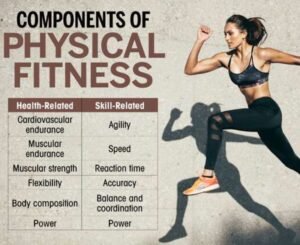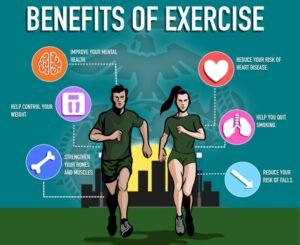Introduction to Physical Fitness
Physical fitness encompasses the harmonious coordination of bodily functions, facilitating overall health and the seamless execution of daily tasks. Its framework comprises 11 facets, with 6 geared towards health enhancement and 5 towards skill refinement. Health-oriented elements encompass body composition, cardiorespiratory endurance, flexibility, muscular endurance, power, and strength, all pivotal for excelling in physical endeavors and athletic pursuits. Conversely, skill-related aspects like agility hold paramount importance in endeavors such as track and field. Achieving holistic physical fitness necessitates addressing both health and skill components.
Health-focused fitness aids in averting conditions like hypertension, diabetes, and osteoporosis, while regular physical activity enhances overall well-being. Meanwhile, skill-based fitness caters to activities reliant on motor proficiency. Embracing physical fitness transcends mere athletic prowess, fostering well-being and vitality through activities like cardiovascular conditioning, strength training, flexibility exercises, and more. Each component plays a unique role in sustaining optimal health and holistic wellness. Consistent exercise not only yields physical benefits but also promotes stress alleviation, bolsters the immune system, enhances sexual function, and fortifies mental well-being.
What are the different components of physical fitness?

Understanding physical fitness involves delving into its multifaceted components, which can be broadly categorized into health-related and skill-related aspects. These components collectively contribute to overall health, wellness, and performance across various activities and sports.
For more details, visit https://us.humankinetics.com
Health-Related Components
1. Body Composition
The cornerstone of physical fitness lies in achieving optimal body composition, which entails maintaining a balance between lean muscle mass and body fat. A healthy body composition is characterized by a higher proportion of lean muscle mass and a lower percentage of body fat, contributing significantly to overall well-being.
2. Cardiorespiratory Endurance
Cardiorespiratory endurance, also known as cardiovascular endurance, exemplifies the efficiency of the heart, lungs, and blood vessels in supplying oxygen to muscles during prolonged physical exertion. This component forms the foundation of stamina and endurance, vital for sustained activity levels and overall cardiovascular health.
3. Flexibility
Flexibility, the ability to move joints through their full range of motion without discomfort, is integral to daily activities and athletic performance alike. Enhancing flexibility not only improves mobility but also reduces the risk of injury, facilitating smooth and fluid movements.
4. Muscular Endurance
Muscular endurance underscores the capacity of muscle groups to sustain repetitive contractions over extended periods of time. It closely intertwines with muscular strength and plays a pivotal role in activities requiring prolonged effort, contributing significantly to overall physical fitness and endurance.
5. Power
Power, characterized by the ability to generate force swiftly, is indispensable for explosive movements such as jumping, sprinting, and throwing. Developing power enhances athletic performance across various disciplines, enabling athletes to execute dynamic movements with precision and efficiency.
6. Strength
Strength, the foundation of physical prowess, denotes the ability of muscles to generate force. It is a fundamental component for activities involving lifting, carrying, and pushing, emphasizing functional fitness and muscular integrity.
Skill-Related Components
1. Agility
Agility encompasses the ability to change direction quickly and efficiently, which is essential for sports requiring rapid directional shifts and quick reflexes. It plays a vital role in enhancing maneuverability and responsiveness on the field or court.
2. Balance
Maintaining equilibrium and stability is paramount in various activities and sports. Balance training improves proprioception and core strength, enhancing stability and reducing the risk of falls and injuries.
3. Coordination
Coordination involves the seamless integration of senses and body parts to execute motor tasks with precision and accuracy. It is a fundamental skill in activities requiring fine motor control, such as dance, gymnastics, and martial arts.
4. Reaction Time
The ability to respond swiftly to stimuli or signals is crucial in dynamic environments, such as sports and competitive settings. Improving reaction time enhances decision-making and responsiveness, augmenting performance across diverse activities.
5. Speed
Speed, the epitome of rapid movement efficiency, holds significance in activities like running, swimming, and cycling. Enhancing speed fosters competitiveness and performance excellence, enabling athletes to achieve peak results in their respective disciplines.
Benefits of physical fitness

The advantages of staying physically fit encompass a wide array of health benefits, including:
- Enhanced Cardiometabolic Health: Engaging in regular physical activity plays a vital role in regulating blood sugar levels, consequently diminishing the likelihood of developing chronic ailments such as type 2 diabetes.
- Augmented Cognitive Function: Physical exertion contributes to heightened attention spans and improved memory retention, thus potentially boosting academic performance across all age groups.
- Promoted Brain Health: Consistent exercise routines have been shown to mitigate the risk of depression and cognitive decline, including conditions like Alzheimer’s disease.
- Strengthened Muscles and Endurance: Active participation in physical activities fosters the development of robust muscles and enhances overall endurance levels.
- Enhanced Cardiovascular Fitness: Routine physical exercise is instrumental in enhancing blood pressure levels and aerobic capacity, thereby mitigating the risk of cardiovascular diseases such as heart attacks and strokes.
- Fortified Bone Structure: Regular workouts aid in fortifying bones and curbing bone density loss, which in turn decreases susceptibility to fractures.
- Weight Management: Active lifestyles contribute to maintaining healthy body weights and reducing excess body fat.
- Long-term Health Gains: Sustained physical activity over time significantly reduces the likelihood of developing chronic conditions like heart disease, stroke, type 2 diabetes, and certain cancers.
- Increased Energy Levels: Engaging in regular exercise routines can provide enduring boosts to energy levels and alleviate feelings of fatigue.
- Enhanced Mental Well-Being: Consistent physical activity has been correlated with a reduction in symptoms associated with anxiety and depression.
- Maintenance of Musculoskeletal Health: Regular physical activity is essential for preserving muscle mass, strength, and bone density.
- Lower Risk of Falls: Incorporating balance and muscle-strengthening exercises into daily routines can be particularly beneficial for older adults, reducing the likelihood of falls and related injuries.
Must Read: WELLBEING: NAVIGATING THE PATH TO INNER HARMONY
How to measure cardiovascular endurance?

Evaluating cardiovascular endurance encompasses various tests, each offering unique insights into one’s fitness level and capacity to utilize oxygen efficiently. These tests serve as benchmarks for assessing current abilities and monitoring progress over time. Among the array of tests available, individuals can employ several methods to gauge their cardiovascular fitness:
1. Resting Heart Rate Test:
Begin by measuring your resting heart rate, which is indicative of your cardiovascular health. Simply place your finger on your pulse and count the beats for 10 seconds, then multiply by six. A lower resting heart rate typically signifies better cardiovascular fitness.
2. Rockport Test:
This assessment aims to determine VO2 max, a crucial indicator of oxygen utilization. Participants briskly walk 1 mile, recording their pulse rate afterward. These metrics are then utilized to calculate their score, offering insights into overall cardiovascular fitness.
3. Treadmill Test:
Professionals administer the treadmill test in gym or lab settings, rigorously exercising while monitoring various vital signs. Blood pressure, heart rate, and perceived exertion are tracked as individuals engage in high-intensity treadmill workouts, providing a comprehensive overview of cardiovascular performance.
4. Astrand Treadmill Test:
Utilizing similar treadmill protocols, the Astrand test focuses on assessing cardiorespiratory fitness by measuring oxygen utilization during exercise. Participants’ heart rate and oxygen consumption are closely monitored, offering insights into their aerobic capacity and endurance levels.
5. Cooper 1.5-Mile Walk-Run Test:
Ideal for less active individuals, this test involves brisk walking or running 1.5 miles as swiftly as possible. The goal is to evaluate cardiovascular endurance and stamina, providing valuable feedback on overall fitness levels.
6. 10-Minute Max Calories on the AirBike:
For an assessment that delves into both aerobic and anaerobic energy systems, individuals engage in an intense 10-minute session on an airbike, aiming to maximize calorie expenditure. This test offers insights into endurance and power development across different energy systems.
7. 30/30 x 4 On the Rower:
Rowing enthusiasts can opt for this interval-based test, involving four intervals of 30 seconds of rowing at high intensity, interspersed with 30 seconds of rest. This assessment targets cardiovascular endurance and power output, providing valuable data for performance enhancement.
By incorporating these diverse tests into their fitness regimen, individuals gain a comprehensive understanding of their cardiovascular fitness levels. Regular engagement in aerobic exercises and physical activity remains paramount for improving cardiovascular endurance, thereby enhancing overall health and well-being. These assessments not only serve as benchmarks for progress but also empower individuals to make informed decisions regarding their fitness journey.
What are some factors that can affect cardiovascular endurance?
Numerous variables play crucial roles in determining cardiovascular endurance, ultimately dictating the body’s capacity to sustain rhythmic, dynamic activities at moderate to high intensity over prolonged durations. These influencing factors encompass a wide spectrum, each exerting distinct effects on physiological function and overall performance:
1. Oxygen Diffusion Capacity of the Lungs:
The efficiency with which the lungs intake oxygen and transport it into the bloodstream profoundly impacts cardiovascular endurance. Optimal lung function ensures adequate oxygen supply to working muscles during physical exertion, sustaining endurance levels.
2. Cardiac Output:
Cardiac output, known as the volume of blood ejected by the heart per minute, directly influences oxygen delivery to muscles during exercise. Enhanced cardiac output correlates with improved oxygen transport efficiency, thereby bolstering cardiovascular endurance.
3. Oxygen Transport Capacity of the Blood:
The blood’s ability to carry oxygen to muscle tissues hinges on various factors, including hemoglobin levels and red blood cell count. Effective oxygen transport is paramount for sustaining prolonged physical activity and optimizing endurance performance.
4. Capillary Density of the Muscles:
Muscular endurance is intricately linked to capillary density within muscle tissues, facilitating efficient oxygen and nutrient delivery during exertion. Higher capillary density enhances endurance by optimizing metabolic processes and delaying fatigue onset.
5. Body Composition:
The ratio of body fat to lean muscle mass profoundly impacts cardiovascular endurance. Excessive body fat necessitates greater cardiovascular effort during activity, potentially impairing endurance. Conversely, a leaner physique enhances aerobic capacity and endurance.
6. Muscular Strength and Endurance:
Integral components of physical fitness, muscular strength, and endurance contribute significantly to cardiovascular health and endurance. Well-developed muscles support efficient movement patterns and energy utilization, enhancing overall endurance capabilities.
7. Flexibility:
Adequate flexibility promotes optimal movement mechanics during exercise, reducing energy expenditure and conserving resources for sustained activity. Improved flexibility mitigates the risk of injury and enhances endurance performance.
8. Training Methods:
The selection and intensity of training methodologies profoundly impact cardiovascular endurance and muscular strength. Incorporating diverse modalities such as resistance training, endurance training, and high-intensity interval training (HIIT) optimizes physiological adaptations, enhancing overall endurance capacity.
9. Dietary Factors:
Nutritional choices significantly influence cardiovascular health and, consequently, endurance levels. Consumption of saturated fatty acids, cholesterol, and excessive dietary salt can compromise cardiovascular function, impairing endurance performance. A balanced diet rich in essential nutrients supports cardiovascular health and enhances endurance capabilities.
By meticulously considering these multifaceted factors and adopting appropriate training modalities, individuals can progressively enhance their cardiovascular endurance, thereby fostering improved physical resilience and mental well-being. Consistent engagement in regular exercise, coupled with sound nutritional practices and lifestyle choices, constitutes the cornerstone of optimal cardiovascular health and endurance attainment.
